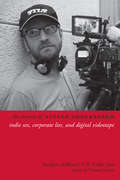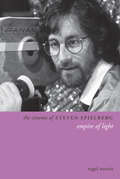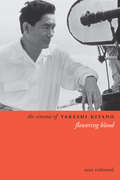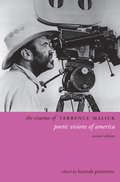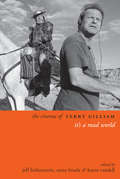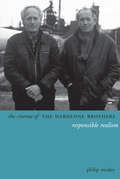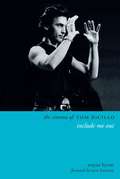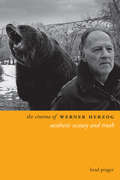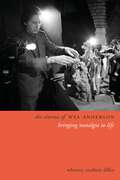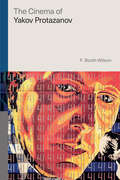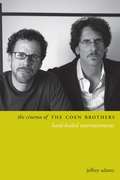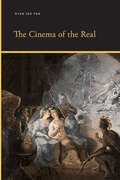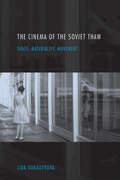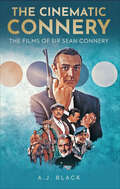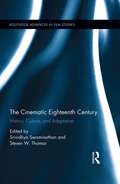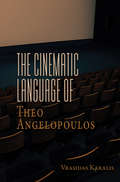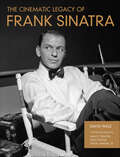- Table View
- List View
The Cinema of Steven Soderbergh: Indie Sex, Corporate Lies, and Digital Videotape (Directors' Cuts)
by R. Colin Tait Andrew deWaardThe industry's only director-cinematographer-screenwriter-producer-actor-editor, Steven Soderbergh is contemporary Hollywood's most innovative and prolific filmmaker. A Palme d'or and Academy Award-winner, Soderbergh has directed nearly thirty films, including political provocations, digital experiments, esoteric documentaries, global blockbusters, and a series of atypical genre films. This volume considers its slippery subject from several perspectives, analyzing Soderbergh as an expressive auteur of art cinema and genre fare, as a politically-motivated guerrilla filmmaker, and as a Hollywood insider. Combining a detective's approach to investigating the truth with a criminal's alternative value system, Soderbergh's films tackle social justice in a corporate world, embodying dozens of cinematic trends and forms advanced in the past twenty-five years. His career demonstrates the richness of contemporary American cinema, and this study gives his complex oeuvre the in-depth analysis it deserves.
The Cinema of Steven Spielberg
by Nigel MorrisCinema's most successful director is a commercial and cultural force demanding serious consideration. Not just triumphant marketing, this international popularity is partly a function of the movies themselves. Polarised critical attitudes largely overlook this, and evidence either unquestioning adulation or vilification& mdash;often vitriolic& mdash;for epitomising contemporary Hollywood. Detailed textual analyses reveal that alongside conventional commercial appeal, Spielberg's movies function consistently as a self-reflexive commentary on cinema. Rather than straightforwardly consumed realism or fantasy, they invite divergent readings and self-conscious spectatorship which contradict assumptions about their ideological tendencies. Exercising powerful emotional appeal, their ambiguities are profitably advantageous in maximising audiences and generating media attention.
The Cinema of Steven Spielberg: Empire of Light (Directors' Cuts)
by Nigel MorrisCinema's most successful director is a commercial and cultural force demanding serious consideration. Not just triumphant marketing, this international popularity is partly a function of the movies themselves. Polarised critical attitudes largely overlook this, and evidence either unquestioning adulation or vilification-often vitriolic-for epitomising contemporary Hollywood. Detailed textual analyses reveal that alongside conventional commercial appeal, Spielberg's movies function consistently as a self-reflexive commentary on cinema. Rather than straightforwardly consumed realism or fantasy, they invite divergent readings and self-conscious spectatorship which contradict assumptions about their ideological tendencies. Exercising powerful emotional appeal, their ambiguities are profitably advantageous in maximising audiences and generating media attention.
The Cinema of Takeshi Kitano: Flowering Blood
by Sean RedmondThe Cinema of Takeshi Kitano: Flowering Blood is a detailed aesthetic, Deleuzian, and phenomenological exploration of Japan's finest currently-working film director, performer, and celebrity. The volume uniquely explores Kitano's oeuvre through the tropes of stillness and movement, becoming animal, melancholy and loss, intensity, schizophrenia, and radical alterity; and through the aesthetic temperatures of color, light, camera movement, performance and urban and oceanic space. In this highly original monograph, all of Kitano's films are given due consideration, including A Scene at the Sea (1991), Sonatine (1993), Dolls (2002), and Outrage (2010).
The Cinema of Takeshi Kitano: Flowering Blood (Directors' Cuts)
by Sean RedmondThe Cinema of Takeshi Kitano: Flowering Blood is a detailed aesthetic, Deleuzian, and phenomenological exploration of Japan's finest currently-working film director, performer, and celebrity. The volume uniquely explores Kitano's oeuvre through the tropes of stillness and movement, becoming animal, melancholy and loss, intensity, schizophrenia, and radical alterity; and through the aesthetic temperatures of color, light, camera movement, performance and urban and oceanic space. In this highly original monograph, all of Kitano's films are given due consideration, including A Scene at the Sea (1991), Sonatine (1993), Dolls (2002), and Outrage (2010).
The Cinema of Terrence Malick
by Hannah PattersonWith 2005's acclaimed and controversial The New World, one of cinema's most enigmatic filmmakers returned to the screen with only his fourth feature film in a career spanning thirty years. While Terrence Malick's work has always divided opinion, his poetic, transcendent filmic language has unquestionably redefined modern cinema, and with a new feature scheduled for 2008, contemporary cinema is finally catching up with his vision. This updated second edition of The Cinema of Terrence Malick: Poetic Visions of America charts the continuing growth of Malick's oeuvre, exploring identity, place, and existence in his films. Featuring two new original essays on his latest career landmark and extensive analysis of The Thin Red Line& mdash;Malick's haunting screen treatment of World War II-this is an essential study of a visionary poet of American cinema.
The Cinema of Terrence Malick: Poetic Visions of America (Directors' Cuts)
by Hannah PattersonWith 2005's acclaimed and controversial The New World, one of cinema's most enigmatic filmmakers returned to the screen with only his fourth feature film in a career spanning thirty years. While Terrence Malick's work has always divided opinion, his poetic, transcendent filmic language has unquestionably redefined modern cinema, and with a new feature scheduled for 2008, contemporary cinema is finally catching up with his vision. This updated second edition of The Cinema of Terrence Malick: Poetic Visions of America charts the continuing growth of Malick's oeuvre, exploring identity, place, and existence in his films. Featuring two new original essays on his latest career landmark and extensive analysis of The Thin Red Line-Malick's haunting screen treatment of World War II-this is an essential study of a visionary poet of American cinema.
The Cinema of Terry Gilliam: It's a Mad World
by Jeff Birkenstein Anna Froula Karen RandellTerry Gilliam has been making movies for more than forty years, and this volume analyzes a selection of his thrilling directorial work, from his early films with Monty Python to The Imaginarium of Doctor Parnussus (2009). The frenetic genius, auteur, and social critic continues to create indelible images on screen--if, that is, he can get funding for his next project. Featuring eleven original essays from an international group of scholars, this collection argues that when Gilliam makes a movie, he goes to war: against Hollywood caution and convention, against American hyper-consumerism and imperial militarism, against narrative vapidity and spoon-fed mediocrity, and against the brutalizing notion and cruel vision of the "American Dream."
The Cinema of Terry Gilliam: It's a Mad World (Directors' Cuts)
by Jeff Birkenstein Anna Froula Karen Randell Eds.Terry Gilliam has been making movies for more than forty years, and this volume analyzes a selection of his thrilling directorial work, from his early films with Monty Python to The Imaginarium of Doctor Parnussus (2009). The frenetic genius, auteur, and social critic continues to create indelible images on screen--if, that is, he can get funding for his next project. Featuring eleven original essays from an international group of scholars, this collection argues that when Gilliam makes a movie, he goes to war: against Hollywood caution and convention, against American hyper-consumerism and imperial militarism, against narrative vapidity and spoon-fed mediocrity, and against the brutalizing notion and cruel vision of the "American Dream."
The Cinema of The Dardenne Brothers: Responsible Realism
by Philip MosleyThe brothers Jean-Pierre and Luc Dardenne have established an international reputation for their emotionally powerful realist cinema. Inspired by their home turf of Liège-Seraing, a former industrial hub of French-speaking southern Belgium, they have crafted a series of fiction films that blends acute observation of life on the social margins with moral fables for the postmodern age. This volume analyses the brothers' career from their leftist video documentaries of the 1970s and 1980s through their debut as directors of fiction films in the late 1980s and early 1990s to their six major achievements from The Promise (1996) to The Kid with a Bike (2011), an oeuvre that includes two Golden Palms at the Cannes film festival, for Rosetta (1999) and The Child (2005). It argues that the ethical dimension of the Dardennes' work complements rather than precludes their sustained expression of a fundamental political sensibility.
The Cinema of Tom DiCillo: Include Me Out (Directors' Cuts)
by Wayne ByrneThis volume considers for the first time in a single collection this acclaimed, award-winning director's entire oeuvre, addressing and analyzing themes such as identity, family, and masculinity, supported by in-depth coverage of the generic and aesthetic aspects of DiCillo's distinctive and influential film style. Through detailed chapters on each of DiCillo's feature films, presented here is a candid look behind-the-scenes of both the American independent film industry - from the No Wave movement of the 1980s, through the Indie boom of the 1990s, to the contemporary milieu - and the Hollywood studio system. This study documents the writing, production, and release of every DiCillo picture, each followed by an extensive Q&A with the director. Also featured are exclusive interviews and commentary with many cast members and collaborators, and members of legendary rock group, The Doors. Films covered include Johnny Suede, Living In Oblivion, Box of Moonlight, The Real Blonde, Double Whammy, Delirious, When You're Strange, and Down in Shadowland.
The Cinema of Werner Herzog
by Kirsten Moana ThompsonWerner Herzog is renowned for pushing the boundaries of conventional cinema, especially those between the fictional and the factual, the fantastic and the real. The Cinema of Werner Herzog: Aesthetic Ecstasy and Truth is the first study in twenty years devoted entirely to an analysis of Herzog's work. It explores the director's continuing search for what he has described as 'ecstatic truth,' drawing on over thirty-five films, from the epics Aguirre: Wrath of God (1972) and Fitzcarraldo (1982) to innovative documentaries like Fata Morgana (1971), Lessons of Darkness (1992), and Grizzly Man (2005). Special attention is paid to Herzog's signature style of cinematic composition, his "romantic" influences, and his fascination with madmen, colonialism, and war.
The Cinema of Werner Herzog
by Kirsten Moana ThompsonWerner Herzog is renowned for pushing the boundaries of conventional cinema, especially those between the fictional and the factual, the fantastic and the real. The Cinema of Werner Herzog: Aesthetic Ecstasy and Truth is the first study in twenty years devoted entirely to an analysis of Herzog's work. It explores the director's continuing search for what he has described as 'ecstatic truth,' drawing on over thirty-five films, from the epics Aguirre: Wrath of God (1972) and Fitzcarraldo (1982) to innovative documentaries like Fata Morgana (1971), Lessons of Darkness (1992), and Grizzly Man (2005). Special attention is paid to Herzog's signature style of cinematic composition, his "romantic" influences, and his fascination with madmen, colonialism, and war.
The Cinema of Werner Herzog: Aesthetic Ecstasy and Truth (Directors' Cuts)
by Brad PragerWerner Herzog is renowned for pushing the boundaries of conventional cinema, especially those between the fictional and the factual, the fantastic and the real. The Cinema of Werner Herzog: Aesthetic Ecstasy and Truth is the first study in twenty years devoted entirely to an analysis of Herzog's work. It explores the director's continuing search for what he has described as 'ecstatic truth,' drawing on over thirty-five films, from the epics Aguirre: Wrath of God (1972) and Fitzcarraldo (1982) to innovative documentaries like Fata Morgana (1971), Lessons of Darkness (1992), and Grizzly Man (2005). Special attention is paid to Herzog's signature style of cinematic composition, his "romantic" influences, and his fascination with madmen, colonialism, and war.
The Cinema of Wes Anderson: Bringing Nostalgia to Life (Directors' Cuts)
by Whitney Crothers DilleyWes Anderson is considered one of the most important directors of the post-Baby Boom generation, making films such as Rushmore (1998) and The Royal Tenenbaums (2001) in a style so distinctive that his films are often recognizable from a single frame. Through the travelogue The Darjeeling Limited (2007) and the stop-motion animation of Fantastic Mr. Fox (2009), his films examine issues of gender, race, and class through dysfunctional family dynamics, with particular focus on masculinity and male bonding. Anderson's auteur status is enriched by his fascination with Truffaut and the French New Wave, as well as his authorship of every one of his screenplays, drawing on influences as diverse as Mark Twain, J. D. Salinger, Roald Dahl, and Stefan Zweig. Works such as Moonrise Kingdom (2012) and The Grand Budapest Hotel (2014) continue to fascinate with their postmodern, hyper-nostalgic attention to detail. This book explores the filmic and literary influences that have helped make Anderson a major voice in 21st century "indie" culture, and reveals why Wes Anderson is one of the most inventive filmmakers working in cinema today.
The Cinema of Yakov Protazanov (Global Film Directors)
by F. Booth WilsonBest known for Aelita (1924), the classic science-fiction film of the Soviet silent era, Yakov Protazanov directed over a hundred films in a career spanning three decades. Called "the Russian D.W. Griffith" in the 1910s for his formative role in the first movies in the last years of the Russian Empire, he fled the Civil War and maintained a successful career in Europe before making an unusual decision to return to Russia now under Soviet power. There his films continued their remarkable success with audiences undergoing a bewildering and often brutal revolutionary transformation. Rather than treating him as an indistinct, if capable craftsman, The Cinema of Yakov Protazanov argues that his films are suffused with a unique creative vision that reflects both his mindset as a traditional Russian intellectual and his experience of dislocation and migration after 1917. As he adapted his films to revolutionary culture, they intermingled different voices and reinterpreted his past work from a disavowed era. Offering fresh perspectives of Protazanov’s films, the book will give readers a new appreciation of his career. The book offers a uniquely valuable vantage point from which to explore how cinema reflected a society in transformation and a seminal moment in the development of cinematic art.
The Cinema of the Coen Brothers
by Jeffrey AdamsThe films of the Coen brothers have become a contemporary cultural phenomenon. Highly acclaimed and commercially successful, over the years their movies have attracted increasingly larger audiences and spawned a subculture of dedicated fans. Shunning fame and celebrity, Ethan and Joel Coen remain maverick filmmakers, producing and directing independent films outside the Hollywood mainstream in a unique style combining classic genres like film noir with black comedy to tell off-beat stories about America and the American Dream. This study provides an overview of the films of the Coen brothers, including multiple-Oscar winning movies like Fargo and No Country for Old Men, as well as cult favorites such as O Brother, Where Art Thou? and The Big Lebowski. Beginning with the 1984 debut Blood Simple, this volume examines the development of the Coens' body of work, identifying and analyzing major themes and generic constructs and offering diverse interpretative approaches to their enigmatic films. Drawing on a wide array of sources, especially the pulp fiction of Dashiell Hammett, James M. Cain, and Raymond Chandler, this study examines the influence of these literary sources as well as key cinematic precursors to reveal how the Coens' intertextual creativity exemplifies the aesthetics of postmodernism.
The Cinema of the Coen Brothers: Hard-Boiled Entertainments (Directors' Cuts)
by Jeffrey AdamsThe films of the Coen brothers have become a contemporary cultural phenomenon. Highly acclaimed and commercially successful, over the years their movies have attracted increasingly larger audiences and spawned a subculture of dedicated fans. Shunning fame and celebrity, Ethan and Joel Coen remain maverick filmmakers, producing and directing independent films outside the Hollywood mainstream in a unique style combining classic genres like film noir with black comedy to tell off-beat stories about America and the American Dream. This study surveys Oscar-winning films, such as Fargo (1996) and No Country for Old Men (2007), as well as cult favorites, including O Brother, Where Art Thou? (2000) and The Big Lebowski (1998). Beginning with Blood Simple (1984), it examines major themes and generic constructs and offers diverse approaches to the Coens' enigmatic films. Pointing to the pulp fiction of Dashiell Hammett, James M. Cain, and Raymond Chandler, the study appreciates the postmodern aesthetics of the Coens' intertextual creativity.
The Cinema of the Dardenne Brothers: Responsible Realism (Directors' Cuts)
by Philip MosleyThe brothers Jean-Pierre and Luc Dardenne have established an international reputation for their emotionally powerful realist cinema. Inspired by their home turf of Liège-Seraing, a former industrial hub of French-speaking southern Belgium, they have crafted a series of fiction films that blends acute observation of life on the social margins with moral fables for the postmodern age. This volume analyses the brothers' career from their leftist video documentaries of the 1970s and 1980s through their debut as directors of fiction films in the late 1980s and early 1990s to their six major achievements from The Promise (1996) to The Kid with a Bike (2011), an oeuvre that includes two Golden Palms at the Cannes film festival, for Rosetta (1999) and The Child (2005). It argues that the ethical dimension of the Dardennes' work complements rather than precludes their sustained expression of a fundamental political sensibility.
The Cinema of the Real (SUNY series, Insinuations: Philosophy, Psychoanalysis, Literature)
by Hyon Joo YooA significant intervention into Lacanian film studies, this book sets forth a new theory of the psychoanalytic Real in cinema. In psychoanalysis, the Real ruptures the Symbolic that organizes law, ideology, and other systems of belief, revealing fissures in this underlying order. The Cinema of the Real explores how transnational cinema and especially South Korean cinema facilitate an encounter with the Real, enabling the emergence of a new political subject. Paying close attention to form, Hyon Joo Yoo reveals the existence of an "emancipatory drive" in films by Jang Hun, Park Chan-wook, Lee Chang-dong, Jia Zhangke, Michael Haneke, Claire Denis, and Bong Joon-ho, among others. Their work in effect provides viewers with a picture of how it looks and feels to be on a trajectory in which the subject and her world can change. Far from being a passive consumer of images, Yoo's spectator enters the space of the Real. Theoretically rigorous and inventive, The Cinema of the Real offers new, transnationally attuned tools for conceptualizing the body, affect, femininity, and spectatorship, as well as fresh readings of both classic and contemporary films.
The Cinema of the Soviet Thaw: Space, Materiality, Movement
by Lida OukaderovaFollowing Joseph Stalin’s death in 1953, the Soviet Union experienced a dramatic resurgence in cinematic production. The period of the Soviet Thaw became known for its relative political and cultural liberalization; its films, formally innovative and socially engaged, were swept to the center of international cinematic discourse. In The Cinema of the Soviet Thaw, Lida Oukaderova provides an in-depth analysis of several Soviet films made between 1958 and 1967 to argue for the centrality of space—as both filmic trope and social concern—to Thaw-era cinema. Opening with a discussion of the USSR’s little-examined late-fifties embrace of panoramic cinema, the book pursues close readings of films by Mikhail Kalatozov, Georgii Danelia, Larisa Shepitko and Kira Muratova, among others. It demonstrates that these directors’ works were motivated by an urge to interrogate and reanimate spatial experience, and through this project to probe critical issues of ideology, social progress, and subjectivity within post–Stalinist culture.
The Cinematic Connery: The Films of Sir Sean Connery
by A. J. BlackScotland’s greatest export. The world’s first super spy. Voted the sexiest man on the planet. Sir Sean Connery was a titanic figure on screen and off for over half a century. Behind the son of a factory worker, growing up in near-poverty on the harsh streets of pre-war Edinburgh, lay a timeless array of motion pictures that spanned multiple decades and saw Connery work across the globe with directors as diverse as Alfred Hitchcock, Steven Spielberg and Michael Bay. And amongst them his greatest role, whether he liked it or not – Bond, James Bond. Author A. J. Black delves into Connery’s life for more than mere biography, exploring not just the enormously varied pictures he made including crowd pleasing blockbusters such as The Untouchables or Indiana Jones and the Last Crusade, serious-minded fare in The Hill or The Offence, and his strange sojourns into eclectic fantasy with Zardoz or Time Bandits, but also the sweep of a career that crossed movie eras as well as decades. From skirmishes with the angry young men of the British New Wave, via becoming the cinematic icon of the 1960s as 007, through to a challenging reinvention as a unique older actor of stature in the 1980s, this exploration of the Cinematic Connery shows just how much his work reflected the changing movie-going tastes, political realities and cultural trends of the 20th century, and beyond . . .
The Cinematic Eighteenth Century: History, Culture, and Adaptation (Routledge Advances in Film Studies)
by Srividhya Swaminathan Steven W. ThomasThis collection explores how film and television depict the complex and diverse milieu of the eighteenth century as a literary, historical, and cultural space. Topics range from adaptations of Austen’s Sense and Sensibility and Defoe's Robinson Crusoe (The Martian) to historical fiction on the subjects of slavery (Belle), piracy (Crossbones and Black Sails), monarchy (The Madness of King George and The Libertine), print culture (Blackadder and National Treasure), and the role of women (Marie Antoinette, The Duchess, and Outlander). This interdisciplinary collection draws from film theory and literary theory to discuss how film and television allows for critical re-visioning as well as revising of the cultural concepts in literary and extra-literary writing about the historical period.
The Cinematic Language of Theo Angelopoulos
by Vrasidas KaralisBeginning with his first film Reconstruction, released in 1970, Theo Angelopoulos’s notoriously complex cinematic language has long explored Greece’s contemporary history and questioned European culture and society. The Cinematic Language of Theo Angelopoulos offers a detailed study and critical discussion of the acclaimed filmmaker’s cinematic aesthetics as they developed over his career, exploring different styles through which Greek and European history, identity, and loss have been visually articulated throughout his oeuvre, as well as his impact on both European and global cinema.
The Cinematic Legacy of Frank Sinatra
by David WillsIn a film career spanning more than five decades, Frank Sinatra proved to be a roulette wheel of constantly spinning talent, the likes of which Hollywood has rarely seen. Film history is filled with stars created by the studio system. Occasionally, however, a performer emerged who, against all preconceived odds of what a star should be or look like, knocked down the walls of convention by becoming nothing other than what they already were. Frank Sinatra was the embodiment of this fundamental truth. The legacy of his work stands apart from many of his contemporaries, who essentially based their performances on an extension of a core character type. Sinatra, however, was able to take his signature persona and translate it successfully into many film genres-first as the comedic song-and-dance man, then as the dramatic actor and romantic lead, and finally as the tough guy and action hero. Sinatra also respectfully challenged contemporary ideals of acting technique. While being humble enough to learn from his peers, he kept his acting style fresh and instinctual, and earned an Oscar at a time when many actors were either classically trained or coached in the "Method." In The Cinematic Legacy of Frank Sinatra, author David Wills presents a stunning collection highlighting the work of one of Hollywood's greatest stars in roles as varied as those in the classics Anchors Aweigh, From Here to Eternity, Suddenly, Guys and Dolls, The Man With the Golden Arm, Ocean's 11, The Manchurian Candidate,Von Ryan's Express, and The Detective. Pairing more than two hundred first-generation photos with reflections on Sinatra from costars and work associates, and including contributing essays by his children Nancy Sinatra, Tina Sinatra, and Frank Sinatra, Jr., it is an unforgettable showcase of the actor's transformation from world-famous singer, to movie star, to Academy Award winner, and finally to one of the most enduring icons in cinema history.
